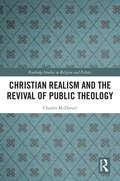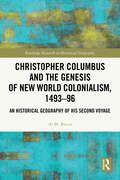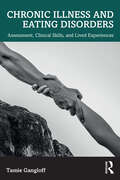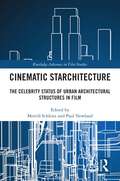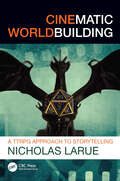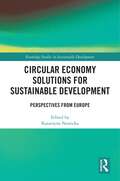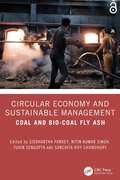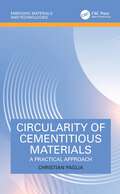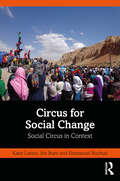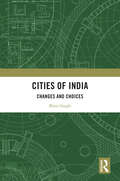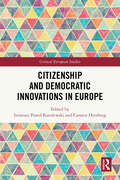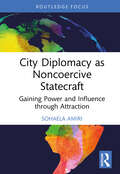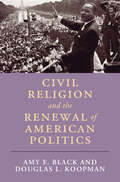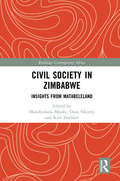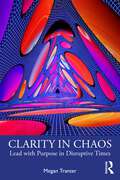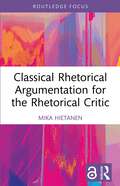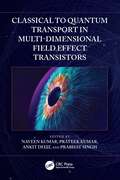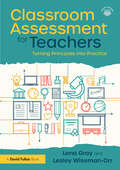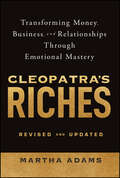- Table View
- List View
Christian Realism and the Revival of Public Theology (Routledge Studies in Religion and Politics)
by Charles McDanielChristian Realism and the Revival of Public Theology analyzes Reinhold Niebuhr’s The Children of Light and the Children of Darkness 80 years after publication and argues that it provides pertinent lessons for the contemporary era. This book considers how Niebuhr’s book—as well as his other work—remains relevant and retains insights for an America which seems increasingly to be losing its moral bearings and political courage. The author examines the roots of political polarization in Niebuhr’s categories of the children of light and the children of darkness, finding it a more useful binary than liberalism vs. conservatism for understanding America’s culture wars and the growing sense that its political institutions are in terminal decay. This book seeks to show how public theology offers resources to foster democratic and moral renewal. It concludes by calling for a reinvigorated civil religion to promote unity rather than division. This book will appeal to scholars of American politics, Christian ethics, Christian Realism, public theology, and American religious history as well as historians of American Christianity.
Christianity and Horror Cinema (Routledge Studies in Religion and Film)
by Bryan P. StoneChristianity and Horror Cinema explores ways that Christian beliefs, spiritualities, practices, and symbols provide the religious and existential "depths" out of which the monsters of Western horror cinema have emerged, arguing that they are, in several respects, the monsters for which Christians are responsible. Horror cinema preys on Christianity’s narrative, moral, cultural, and aesthetic traditions; reverses them; upends them; inverts them; and offends them. But it also reflects and relies on them. The book focuses on seven subgenres in the cinema of horror: ghosts, witches, the demonic or Satanic, vampires, nature horror, zombies, and psychological horror. Each chapter traces the history of that subgenre, taking up a theological analysis of ways that horror cinema capitalizes on ambiguities, contradictions, anxieties, and tensions in Christianity—for example, its treatment of the body, nature, sexuality, women, or those it deems pagan or religiously "other." The author examines a variety of films that are important for thinking about the relationship of Christianity to horror cinema. The book will be of interest to scholars of religion, theology, and film studies.
Christopher Columbus and the Genesis of New World Colonialism, 1493–96: An Historical Geography of his Second Voyage (Routledge Research in Historical Geography)
by Al M. RoccaThis book explores the role of geography’s five themes: location, place, human-environmental interaction, movement, and region, in Christopher Colombus’s second voyage. It explores the impacting events that led to deteriorating relations between Columbus, the Spanish settlers (adventurers), and the indigenous Taíno and Carib people, creating a social paradigm of confusion, displacement, destruction, and the genesis of New World Colonization.
Chronic Illness and Eating Disorders: Assessment, Clinical Skills, and Lived Experiences
by Tamie GangloffChronic Illness and Eating Disorders addresses the intersection of eating disorders and the importance of treatment of clients with eating disorders and chronic illness, specific interventions, and resilience in a body that continues to change.This book explores the intricacies of those with chronic illness, and how it can lead to disordered eating. Chapters cover lifelong and acquired illnesses and conditions, visible and invisible disabilities, sports injuries, chronic pain, grief, and more. The author examines how each of these conditions can affect appetite, body image, and overall perception of food and health. Treatments such as EMDR and CBT are discussed alongside mindful approaches such as body neutrality.Therapists, dietitians, and other medical professionals will gain a deep understanding of body image disturbance and how that is different than body image distortion.
Cinematic Starchitecture: The Celebrity Status of Urban Architectural Structures in Film (Routledge Advances in Film Studies)
by Paul Newland Merrill SchleierCinematic Starchitecture explores how examples of famous architecture have circulated throughout cinema history across diverse genres. Building on the term "starchitecture" – coined in 1997 for dramatic, monumental structures designed to gain international attention and economic advantage – the authors demonstrate that a crucial part of an architectural structure’s iconic star status emerges through its engagement with (and codification by) the media, and with cinema in particular. This book explores how iconic architectural structures have performed a myriad of roles and functions that exceed buildings’ everyday uses or identities as aesthetic objects, location markers, or spatial settings, to show that countless films globally have featured famous buildings as inimitable components of narrative exposition, character development and/or identity construction. This volume will appeal to students, scholars, and researchers of film studies, media studies, and architecture and architectural history, as well as those in the areas of media and cultural studies, history, popular culture, and urban geography.
Cinematic Worldbuilding: A TTRPG Approach to Storytelling
by Nicholas LaRueEverybody has a story in them. Some people lack the language and the tools to tell that story effectively. As an avid tabletop role-playing game player, I’m amazed at people’s ability to tell stories on the spot. Both the players and the game masters are creating worlds in their minds and playing out the events, using improv, in real-time. Being an author and screenwriter, I know how difficult it is to create consistent and well-constructed characters, themes, and conflicts. I believe that storytellers looking to level up in the classroom, their hobby, or career could learn a lot from games like Dungeons & Dragons, Pathfinder, and others. This book seeks to give people the tools and language to create and master their worlds and characters, using TTRPG mechanics and rulesets as foundational elements. This book will contain insights and interviews from some of today’s most respected game masters, players, actual play actors, and we’ll also hear from some of the people behind the scenes responsible for creating these games, and how they view worldbuilding and storytelling for their audiences.
Circular Economy Solutions for Sustainable Development: Perspectives from Europe (Routledge Studies in Sustainable Development)
by Katarzyna NowickaThis edited collection offers fresh perspectives on sustainable development and social impact using a circular economy framework. Against the backdrop of escalating environmental challenges such as resource depletion and climate change, transitioning from a linear to a circular economy is a key step towards meeting the UN’s Sustainable Development Goals.Circular supply chains are pivotal in this transformation, focusing on resource efficiency, recycling, and waste reduction, with consumer roles also playing a key part. Building on theoretical foundations, the chapters in this book use quantitative and qualitative research to explore practical solutions and transformative potential across industries and urban settings, addressing global economic, environmental and social challenges. This book fosters a deeper understanding of circular economy principles and inspires actionable changes, with consumers becoming active participants in the circular economy. By focusing on consumer knowledge, eco‑innovation, and urban readiness, it provides a systemic, holistic approach to circular economy studies.This book will be of interest to researchers, academics, and students interested in enhancing their understanding of circular economy principles and practices, including those in environmental science, sustainable development, economics, and business.
Circular Economy and Sustainable Management: Coal and Bio-Coal Fly Ash
by Nitin Kumar Singh Siddhartha Pandey Tuhin Sengupta Sanchita Roy ChowdhuryThis book summarizes both conventional and emerging waste management approaches for fly ash, particularly with a focus on sustainability dimension – including its applicability, scope, methods, and challenges of bio-coal production. It covers the sustainability aspects of fly ash management and recent developments in methods, processes, and scope of bio-coal production as an alternative to conventional coal along with its implications for industrial ecosystems. It focuses on climate change, sustainability, and circular economy aspects of fly ash management approaches. Comprehensively covers all the dimensions related to coal and bio-coal fly ash and circular economy associated with it Discusses cradle-to-grave technology for bio-coal Emphasizes the efficient, economically viable, and environmentally sustainable use of coal and bio-coal fly ash Explores renewable fuel solutions and circular economy associated with it Encourages the use of bio-coal for boosting sustainability and circular economy This book is aimed at researchers and graduate students in environmental and civil engineering, as well as those working in clean technologies.
Circularity of Cementitious Materials: A Practical Approach (Emerging Materials and Technologies)
by Christian PagliaRecycling of materials in building and infrastructure applications are global concerns driven by natural resource preservation needs of modernized countries and sustainable development of emerging countries. This practical book explores the strategies necessary for successful recycling of cement-based materials to achieve sustainable and long service life. It investigates recycled cementitious materials to ensure decisive implementation and meet industry and societal challenges. Presents the state of the art in recycling one of the most used materials in today’s construction sector Covers construction and demolition waste and recycled concrete, UHPC, and road base material Aimed at readers in materials, civil, and construction engineering, this book offers guidance to professionals and researchers developing strategies for sustainable application of cement-based materials.
Circus for Social Change: Social Circus in Context (Routledge Advances in Theatre & Performance Studies)
by Katie Lavers Jon Burtt Emmanuel BochudIn this volume Social Circus is explored in depth by three Circus Studies scholars working with the aim of creating new ways of engaging with the field.Lavers, Burtt, and Bochud investigate the way that Social Circus transforms in response to its immediate environment, and particularly its social, political, and cultural context. Extensively illustrated, with photos of different Social Circuses around the world, and extensively annotated, Circus for Social Change: Social Circus in Context provides a portal into ways of seeing today’s Social Circus and is of interest to practitioners and scholars. Social Circuses explored in this volume include Cirqiniq in far North Canada; Galway Community Circus in the Republic of Ireland; Zip Zap Circus in Cape Town, South Africa; Circus Harmony in St. Louis, Missouri; Circus Laheto in Central Brazil; Women’s Circus in Melbourne, Australia; the Mobile Mini Children’s Circus (the MMCC) in various locations across Afghanistan; Cirque Hors Piste in Montreal, Canada; Sencirk in Dakar, Senegal; the Slow Circus Academy in Yokohama, JDS/Juggling de Shinshu, and the Moon Night Project in Nagano, Japan; Ponleu Selpak’s Performing Arts School and Phare Circus in Cambodia; Sirkus Magenta in Helsinki, Finland; and Le Plus Petit Cirque du Monde in Bagneux in the outskirts of Paris, France.This book will be of great interest to the general reader, to practitioners working within Social Circus or arts for social change, and to scholars, teachers, and students in schools, colleges, and universities.
Cities in the Metaverse: Spatial Computing, Digital Twins, Avatars, Economics and Digital Habitation on the New Frontier
by Duncan Wilson Andrew Hudson-Smith Valerio SignorelliCities in the Metaverse offers a comprehensive exploration of the intersection between urban environments and digital realms. The book examines:· The size and shape of cities in the Metaverse· Spatial computing and its impact on digital interaction· Digital twins in urban planning and management· Avatars and social dynamics in virtual spaces· Economic models emerging in the Metaverse· The influence of gaming on immersive digital landscapes· The impact of Artificial Intelligence on the Metaverse· Potential futures of digital habitationDrawing from architecture, computer science, urban planning, geography, social studies, and economics, the authors provide a multidisciplinary analysis of how virtual cities are shaping our digital future. Using key case studies, they trace the evolution from early cyberspace concepts to current spatial computing technologies, offering insights into both historical context and future possibilities. The book addresses key questions about the opportunities and challenges presented by metaverse technologies, including issues of accessibility, creativity, and the future of humans and artificial intelligence co-existing, side by side, in digital spaces. It serves as a practical guide, equipping readers with the knowledge they need to navigate the future of urban life in virtual environments with a thought-provoking examination of how we might build, inhabit, and govern cities in the Metaverse.The authors explore the concept of digital twins, demonstrating how these virtual replicas of physical spaces can revolutionise urban planning and management. They delve into the social aspects of the metaverse, examining how avatars shape our interactions and relationships in digital realms. Economic considerations are central to the book ethos, with an analysis of emerging models that often leverage blockchain technologies. The book addresses the challenges, potential pitfalls and ethical considerations in creating and inhabiting digital cities. At the same time, it takes a step back and examines already abandoned digital worlds, offering lessons from past attempts at creating virtual spaces. Essential reading for urban planners, geographers, economists, technologists, policymakers, and anyone interested in the future of cities and digital interaction, Cities in the Metaverse provides a balanced, informed perspective on this rapidly evolving field.
Cities of India: Changes and Choices
by Binti SinghUrban India stands at an interesting moment in history—at the cusp of massive changes and cautious choices. This book maps the new challenges and subsequent choices that emerge as India transitions into more urbanized situations, both spatially and culturally—to cleaner and renewable energy, integrating these new norms into the built environment, providing affordable and accessible physical and social infrastructure to all citizens, addressing the disproportionate climate risks of vulnerable communities, responding to the forces of globalization, conserving our heritage assets, deploying smart technologies for better city governance, designing for all, integrating hard and soft city dimensions for better policy outcomes and greater environmental and social impacts. It underlines and explores the nuances of urban design and urban planning, as well as how they are inextricably enmeshed with sustainability and climate action.The volume will be of great interest to scholars and researchers of urban studies, sociology, South Asian Studies, built environment, sustainability and climate studies, urban design and urban planning.
Citizenship and Democratic Innovations in Europe (Critical European Studies)
by Carsten Herzberg Ireneusz Paweł KarolewskiThis book brings together scholarship and debates on citizenship and democratic innovation, and examines how democratic innovations might change, or even consolidate, the existing contours of citizenship.Arguing that the nexus between research on citizenship and democratic innovations can be found in the praxis approach to citizenship, where citizenship can be framed as a realm of actions and practices, the book shifts the discussion from the institutional level into a more conceptual realm of analysis. Taking stock of the democratic innovations at the local level, the national level, and the EU-level, such as citizen assemblies, referendums, and participatory budgeting, the book further surveys and maps their contribution to the democratic quality of citizenship across various European countries.This book is of key interest to scholars and students of democratic innovations, citizenship studies, democratization, governance, and more generally public policy, and European Politics and Studies.
City Diplomacy as Noncoercive Statecraft: Gaining Power and Influence through Attraction
by Sohaela AmiriThis book presents a rigorously designed framework for city diplomacy as a tool to enhance a nation’s international appeal, attraction, and influence. This book illustrates how attraction-based influence is generated, and why city diplomacy enhances national security and prosperity through international exchanges, collaborations, and dialogues.It provides a structured approach to guide policies, strategies, research, and analysis for city diplomacy and the broader field of international affairs.
Civil Religion and the Renewal of American Politics (Cambridge Studies in Religion, Philosophy, and Society)
by Amy E. Black Douglas L. KoopmanAmerican culture is evolving rapidly as a result of shifts in its religious landscape. American civil religion is robust enough to make room for new perspectives, as religious pluralism is foundational for democracy. Moreover, as Amy Black and Douglas L. Koopman argue, American religion and politics are indivisible. In this study, they interrogate three visions of American identity: Christian nationalism, strict secularism, and civil religion. Whereas the growth of Christian nationalism and strict secularism foster division and threaten consensus, by contrast, a dynamic, self-critical civil religion strengthens democracy. When civil religion makes room for robust religious pluralism to thrive, religious and nonreligious people can coexist peacefully in the public square. Integrating insights from political science, history, religious studies, and sociology, Black and Koopman trace the role of religion in American politics and culture, assess the current religious and political landscape, and offer insights into paths by which the United States might reach a new working consensus that strengthens democracy.
Civil Society in Zimbabwe: Insights from Matabeleland (Routledge Contemporary Africa)
by Mandlenkosi Mpofu, Dion Nkomo and Kirk HellikerThis book considers the historical and spatial dimensions of civil society in Zimbabwe’s Matabeleland region, an area suffering from severe development and democratic deficits over many decades.Transcending an organisational conception of civil society and a simplistic state-civil society dualist understanding, it recognises the dynamic character of civil society as a social space, inclusive of less formalised associational forms of collective life, as well as the colonial character and legacies of civil society both analytically and empirically. This book facilitates a nuanced understanding of the specificities of the social, political, and economic evolution of Matabeleland in colonial and post-colonial Zimbabwe, and the region’s troubled relations with the central state. Historically, it traces civil society in Matabeleland from the region’s resistance against the colonial-settler state to contemporary struggles for justice given the unresolved Gukurahundi legacy. Civil society is depicted as constituted by a set of complex and shifting struggles for justice, not simply between Matabeleland and the central state, but also internally within Matabeleland along multiple fault lines including class and culture. The relevance of understanding civil society in Matabeleland, for Zimbabwe and Africa more widely, is brought to the fore.The book will be of interest and value to scholars of civil society, politics and democratisation across the African continent.
Clarity in Chaos: Lead with Purpose in Disruptive Times
by Megan TranterWith its fresh and deeply personal perspective on what it takes to lead with resilience and authenticity, this book challenges the traditional playbook on leadership by placing purpose at the core of every decision and action.In a world increasingly defined by uncertainty and rapid change, leadership grounded in purpose is the compass that transforms uncertainty into impact, stagnation into growth, and vision into a legacy. Drawing on her extraordinary journey from technical safety expert to global executive, Megan Tranter weaves together compelling personal anecdotes, cutting-edge research, and practical tools to show how leaders can redefine success. But this book goes beyond strategies to invite readers into an authentic dialogue about vulnerability, growth, and the kind of leadership that transforms lives – not just spreadsheets. Readers will be left feeling understood, inspired, and empowered to take courageous actions in their careers, solving the pervasive problems of burnout, disconnection, and lack of fulfillment.This book is the roadmap for seasoned executives and aspiring leaders to unlock their potential and lead with clarity and conviction.
Clashing Vulnerabilities, Disability and Conflict (Interdisciplinary Disability Studies)
by Don Kulick Simo VehmasThis book is about how we might think about vulnerability—what it is and how it operates—by looking at cases where different kinds of vulnerabilities clash. Disability is often portrayed as a vulnerability in itself, and disabled people are often labelled a prototypical “vulnerable group”. This book disassembles that label by highlighting how vulnerabilities involving people with disabilities emerge and how they often conflict with other vulnerabilities: the vulnerabilities of disabled students vs. the vulnerabilities of under-educated and harassed teachers, for example. Or the struggles for legitimacy that pit neuro-divergent groups against people with chronic illnesses, one casting doubt on the validity of the other. Or the different uses of curb cuts for people in wheelchairs and people with visual impairments—uses which sometimes clash. Clashes like these illustrate the role that conflict plays in defining “vulnerability” and they lead us to think about how we might try to adjudicate between different claims of what can count as a vulnerability.Providing new insight into power and non-power, ideology, socioeconomic structures, and the vicissitudes of disability as both a subject position and a lived experience, this book will be of interest to scholars and students of disability studies, anthropology and sociology, policy, and philosophy.
Classed Emotions: Navigating Social Class and Emotions in the Urban Indian and Diasporic Contexts (Urban Futures)
by Anna Romanowicz Ahana ChoudhuryThis book explores how urban spaces encompass, shape and reconfigure the emotional landscapes and socio-cultural specters of their inhabitants. It highlights the arenas in which various politics and strategies of emotional relations are represented, created, enacted and regulated through the inhabitants’ lives and lifestyles. Exploring this, the chapters in the volume bring together and analyze the myriad forms of intersections within and between urban centers in India and the Indian diaspora, as well as ‘classed’ emotions. The authors embark on scholarly inquiries to highlight the complex and fluid dynamics through which urban spaces and the class of their inhabitants question, attribute, influence and perpetuate the diverse emotional states and responses, and vice versa – they examine the ways in which emotive subjectivities, relations, experiences and practices question and influence multiple urban formations, power dynamics and spaces. They reveal how emotional and urban landscapes are not only represented but are also affected by the social class of the denizens. Part of the Urban Futures series, the volume will be indispensable to scholars and researchers of urban studies, anthropology, sociology, cultural studies, urban planning, urban policy, public policy and architecture. It will also be of interest to the professional architects, urban designers, social geographers and policymakers.
Classical Mechanics
by Artemio González–LópezClassical Mechanics is a textbook for undergraduate students majoring in Physics (or Mathematics and Physics). The book introduces the main ideas and concepts of Newtonian, Lagrangian, and Hamiltonian mechanics, including the basics of rigid body motion and relativistic dynamics, at an intermediate to advanced level. The physical prerequisites are minimal, with a short primer included in the first chapter. As to the mathematical prerequisites, only a working knowledge of linear algebra, basic multivariate calculus, and the rudiments of ordinary differential equations is expected.Features Numerous exercises and examples A focus on mathematical rigor that will appeal to Physics students wanting to specialize in theoretical physics, or Mathematics students interested in math- ematical physics Sufficient material to service either a one- or two-semester course
Classical Mechanics: A Computational Approach with Examples Using Mathematica and Python
by Vasilis Pagonis Christopher W. KulpClassical Mechanics: A Computational Approach with Examples using Python and Mathematica provides a unique, contemporary introduction to classical mechanics, with a focus on computational methods. In addition to providing clear and thorough coverage of key topics, this textbook includes integrated instructions and treatments of computation.This newly updated and revised second edition includes two new appendices instructing the reader in both the Python and Mathematica languages. All worked example problems in the second edition contain both Python and Mathematica code. New end-of-chapter problems explore the application of computational methods to classical mechanics problems.Full of pedagogy, it contains both analytical and computational example problems within the body of each chapter. The example problems teach readers both analytical methods and how to use computer algebra systems and computer programming to solve problems in classical mechanics. End-of-chapter problems allow students to hone their skills in problem solving with and without the use of a computer. The methods presented in this book can then be used by students when solving problems in other fields both within and outside of physics.It is an ideal textbook for undergraduate students in physics, mathematics, and engineering studying classical mechanics.Key Features: Gives readers the "big picture" of classical mechanics and the importance of computation in the solution of problems in physics Numerous example problems using both analytical and computational methods, as well as explanations as to how and why specific techniques were used Online resources containing specific example codes to help students learn computational methods and write their own algorithms A solutions manual is available via the Routledge Instructor Hub and all example codes in the book are available via the Support Material tab, and at the book’s GitHub page: https://github.com/vpagonis/Classical_Mechanics_2nd_Edition
Classical Rhetorical Argumentation for the Rhetorical Critic (Routledge Studies in Rhetoric and Communication)
by Mika HietanenThis book offers a reassessment of argumentation in classical rhetoric, foregrounding its rational dimension. Moving beyond introductions, it provides insights from Aristotle, Quintilian, and other ancient thinkers while addressing common misconceptions and offering clarifications that are particularly valuable for the rhetorical critic.Adopting a Scandinavian rhetorical perspective, this book argues that classical rhetoric offers enduring tools for both the analysis and the construction of persuasive argumentation. By bridging theory and practice, it demonstrates how classical rhetoric remains highly relevant, while also naturally integrating with analyses that focus on classical concepts such as ethos, pathos, or style – whether through neo‑Aristotelian methods or contemporary approaches rooted in the classical rhetorical tradition. Key concepts are explored in dedicated chapters: the ‘art’ of logos‑based argumentation is reassessed; enthymeme and epicheireme structures are examined; and topoi and staseis are discussed in relation to their later developments. A chapter on the centenary of rhetorical criticism traces its evolution from Herbert Wichelns (1925) to today, proposing a new template for the rhetorical critic.This concise yet comprehensive book will interest intermediate and advanced students, as well as scholars of rhetoric, argumentation, persuasion, speech and writing studies, and communication studies.
Classical to Quantum Transport in Multi-Dimensional Field Effect Transistors
by Naveen Kumar Ankit Dixit Prateek Kumar Prabhat SinghClassical to Quantum Transport in Multi‑Dimensional Field Effect Transistors offers a wide range of topics with attractive images and informative explanations. It begins with an exploration of the fundamentals of field effect transistor (FET) functioning, emphasizing how behavior is governed by classical models. As the semiconductor industry pushes the boundaries of miniaturization and performance, Multi-Dimensional Field Effect Transistors (MuDFETs) and emerging material platforms are redefining the foundations of modern electronics. This book offers a deep and insightful journey through the evolving landscape of advanced FET architectures—from classical conduction models to quantum and ballistic transport regimes. Authored by experts across academia and research institutions, this book offers in-depth discussions on:• Multi-Dimensional and Junctionless FETs: Design innovations enabling superior control, scaling, and performance.• 2D Materials & Transition Metal Dichalcogenides (TMDCs): Harnessing atomically thin semiconductors for next‑generation device engineering.• Nanosheet Transistors: Unlocking new dimensions in charge transport and quantum confinement.• Charge transport mechanisms from classical, semiclassical to ballistic regimes in nanosheet and nanowire FETs.• Tunnel Field Effect Transistor (TFET)-Based Biosensors: Cutting-edge developments in label‑free, ultra-sensitive detection for healthcare and environmental monitoring.• Integration of FET platforms in nonlinear and quantum photonics using silicon nitride waveguides.Whether you’re exploring the quantum limits of device physics or developing real-world sensing solutions, this collection bridges theory and application in one compelling volume. With contributions from leading researchers and technologists, this book serves as a vital reference for academics, graduate students, and professionals working in nanoelectronics, semiconductor devices, biosensors, and photonic field.
Classroom Assessment for Teachers: Turning Principles into Practice
by Lena Gray Lesley Wiseman-OrrThis accessible guide shows just how straightforward it can be to create excellent classroom assessment for formative or summative purposes, giving you confidence in your assessment practices.It clearly sets out the principles underpinning all good educational assessment and translates them into a series of clear practical steps. These can be put into practice in a wide range of classroom contexts to fit the purposes of every teacher. Written by two assessment specialists with decades of experience in the UK and internationally, this readable and well-structured text encourages teachers to examine assumptions and challenge the use of assessment that is not fit for purpose. Including summaries of key ideas, questions and key takeaways, chapters cover: The purposes of educational assessment Understanding what you want to assess How to get the evidence you need Assessment design The outcomes of assessment and providing feedback Designed to inspire and support busy teachers and teachers in training across both primary and secondary phases, this book is a valuable resource for creating the kinds of assessment that will benefit learners in the ways that all good assessment should.
Cleopatra's Riches: Transforming Money, Business, and Relationships Through Emotional Mastery, Revised and Updated
by Martha AdamsA new edition of the guidebook to transforming your relationship with money In the newly revised edition of Cleopatra’s Riches: Transforming Money, Business, and Relationships Through Emotional Mastery, internationally renowned Certified Financial Planner and financial educator, Martha Adams, reveals a transformative new way to think and feel about, and engage with, money. She offers a fresh, human-centered approach that puts you at the heart of your own personalized financial journey. This book is the key to regaining your financial power and redefining your emotional relationship with money. You’ll rediscover money as a source of joy, growth, and purpose as you navigate the author’s one-of-a-kind 4R Process.™ Inside the book: Move from a mindset of financial anxiety to financial empowerment by reshaping your emotional associations with money Nurture your emotional well-being by ensuring that your money decisions improve your wealth and mental health Apply the 4R Process™ to key areas of your life, including business and entrepreneurship, couples, family, and leadership This isn’t just a book about managing dollars and cents or understanding your household’s balance sheet. Cleopatra’s Riches is a custom roadmap to mastering your money mindsets and imbuing your financial outlook with confidence, clarity, and compassion.
